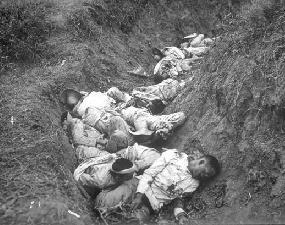History 2710 MacKay
U.S. Imperialism and the Great War (1890s-1910s)
Chronology -- U.S. Imperialism
- 1898 Spanish-American War. Treaty of Paris gives U.S. control of Philippines, Guam, Puerto Rico. U.S. annexes Hawaii
- 1899-1902 American-Filipino War
- 1899-1900 U.S. pursues "Open Door" policy toward China
- 1900 U.S. annexes Puerto Rico. U.S. and other imperial powers put down Chinese Boxer Rebellion
- 1901 U.S. forces Cuba to adopt constitution favorable to U.S. interests
- 1903 Hay--Bunau-Varillia Treaty signed, giving U.S. control of Panama Canal Zone
- 1904 "Roosevelt Corollary" to Monroe Doctrine proclaimed
- 1905 Roosevelt negotiates end to Russo-Japanese War
- 1906-1917 U.S. intervenes in Cuba, Nicaragua, Haiti, Dominican Republic, and Mexico
- 1910 Mexican revolution
- 1914 Panama Canal Opens
- 1914 U.S. invades Mexico
Chronology -- Clash of Empires
- 1914 World War One is triggered by the assassination of Archduke Ferdinand
- 1915 Lusitanian sunk
- 1917 Germany resumes unrestricted submarine warfare. U.S. declares war on Germany
- 1917 U.S. purchases Virgin Islands from Denmark
- 1917 Russian Revolution
- 11-11-1918 Treaty of Versailles, Wilson's 14 Points
Historian Solomon Modell defines imperialism as:
"a policy of extending a country’s power beyond its own borders for the purpose of exploiting other lands and other peoples by establishing economic, social or political control over them."
From the 1803 purchase of Louisiana, the United States had followed a course of expansion. The horrors of the Civil War had interrupted the original Manifest Destiny that began in the 1840s. In the post-Civil War years as the United States fought the last Indian wars, expansionists looked to establish two spheres of influence -- the Pacific and the Caribbean.
We will consider an example of U.S. imperialism: the Philippine insurrection (1898-1902). We will also consider the clash of empires in the Great War--World War I
Over 16,000 Filipino soldiers died and it is estimated that close to 200,000 Filipino civilians lost their lives as well. Some 5,000 American soldiers died. (National Museum of Health and Medicine)
Between the end of the Spanish-American War and the dawn of the Great Depression, the United States sent troops to Latin American countries thirty-two times. It used the Roosevelt Corollary, or addition, to the Monroe Doctrine to justify intervention. In the corollary, Teddy Roosevelt proclaimed that the United States, because it was a "civilized nation," had the right to stop "chronic wrongdoing" throughout the Western Hemisphere (See: A History of U.S. Interventions in Latin American)
No one would have dared to predict the casualties of World War One. When war was declared in August 1914, there were street celebrations in most of Europe's capital cities. No one even envisaged trench warfare let alone the appalling casualties that occurred over 4 years of fighting. In August 1914, Ypres remained a fine example of a medieval city. By 1918, it lay in ruins and the surrounding land had witnessed death by the tens of thousands. The Somme and Verdun witnessed appalling slaughter. No one could have predicted the horrifying consequences of modern weaponry being used together with out-of-date tactics. The grim figures 'speak' for themselves.
Readings:
- Zinn: chapters: 12 & 14
- Study the political cartoons Civilization Begins at Home and What the U.S. Has Fought For. What is the cartoonist saying about American foreign policy? What attitudes toward foreign nations does the cartoonist think are wrong? What aspects of American history and society are criticized in the cartoon? Do you agree with the ideas expressed by the cartoon?
- Casualties World War I
- from History on the Net: Causes of World War I
- Review some of the posters created to promote public support for World War One. What other actions did the government take to create a national consensus for war once the U.S. declared war on Germany?
- President Wilson's 14 Points
Topic #4 Choose one:
- Read "Lessons From The Philippines Insurrection and Our Overthrow of Mossadegh," posted by Lawrence R. Velvel, Dean of the Massachusetts School of Law,n his blog, 2007, and comment based on your understanding of the issues in the rise of the American Empire, 1890s-1910.
- Review the PBS site in support of the documentary series The Great War. Consider particularly the section "The Shaping of the 21st century." How do you understand the evaluations presented by the scholars?


